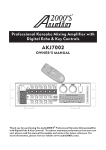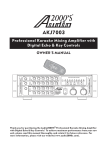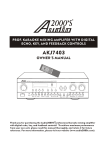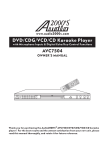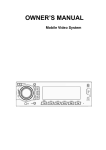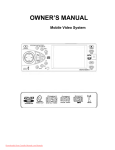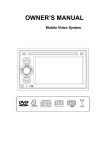Download to extract the AWM6526U Owner`s Manual.
Transcript
PROFESSIONAL FOUR-CHANNEL UHF WIRELESS SYSTEM WITH 16 ADJUSTABLE FREQUENCIES AWM6526U OWNER'S MANUAL ® Thank you for purchasing the Audio2000'S professional four-channel UHF wireless system with 16 adjustable frequencies! For the best results and the utmost satisfaction from your new unit, please read this manual thoroughly, and retain it for future reference. TABLE OF CONTENTS Warning .......................................................................... 1 Precautions ..................................................................... 1 Package Contents ............................................................ 2 Quick Setup ..................................................................... 3 Features ......................................................................... 6 System Configurations ..................................................... 7 System Functions ............................................................ 8 Operation - AWR6526U .................................................... 8 Operation - AWX6526U ................................................... 10 Operation Notes ............................................................. 12 Specifications ................................................................ 13 Troubleshooting ............................................................. 14 Service Information ........................................................ 16 WARNING To prevent fire or shock hazard, do not expose the unit to rain or moisture. Dangerously high voltages are present inside the unit. Do not open the cabinet. Refer servicing to qualified personnel only. PRECAUTIONS On Safety * Operate only on designated AC power supply (120V AC in North America). * Should any liquid or solid object fall into the cabinet, unplug the unit and have it checked by qualified personnel before operating it any further. -1- * Unplug the unit from the wall outlet or set the Master switch to OFF if it is not to be used for several days. * To disconnect the cord, pull it out by the plug. Never pull the cord itself. On Installation * Allow adequate air circulation to prevent internal heat build-up. Do not place the unit on surfaces (rugs, blankets, etc.) or near materials (curtains, draperies) that may block the ventilation holes. * Do not install the unit in a location near heat sources such as radiators or air ducts, or in a place subject to direct sunlight, excessive dust, mechanical vibration or shock. On Repackaging Do not throw away the carton and packing materials. They make an ideal container in which to transport the unit. When shipping the unit to another location, repack it as it was originally packed at the factory. PACKAGE CONTENTS Items Quantities AWR6526U Receiver Wireless Transmitters (Handheld Microphones and/or Body-Pack Transmitters ) AC/DC Adaptor Antennas ¼” to ¼” Cable Rack-Mount Ear Kit AA Batteries (Two for Each Transmitter) Owner's Manual - 2- 1 4 1 2 1 1 8 1 QUICK SETUP A. Remove packing material B. Install the AWR6526U receiver 1. Place the AWR6526U receiver at a location at least 3.5 feet (1 meter) away from the ground and all the walls. Also, keep the AWR6526U receiver away from any electro-magnetic noise sources as far as possible. 2. Mount both the antennas onto the left and right TNC antenna jacks. Make sure that any of the antennas is not enclosed in a large metal body. 3. Plug the supplied AC/DC adaptor 12VDC output connector to the AWR6526U receiver's DC input, and then plug the AC input of the adaptor to a 120V AC outlet (North America). 4. Connect the outputs of the AWR6526U receiver to microphone inputs of a mixer or a sound system. In order to do so, (1) you could use the supplied microphone cable (a cable with ¼” connectors on both ends) to connect from the unbalanced output (an ¼” jack) to an ¼” microphone input on a mixer or a sound system; or (2) you could get four balanced microphone cables (cables with a male XLR connector at one end and a female XLR connector on the other end; not included in the package) to connect from all four balanced outputs (male XLR jacks) to four balanced microphone inputs (female XLR jacks) on a mixer or a sound system. 5. Turn all four audio level adjustment knobs all the way to the minimal audio position. Press the power On/Off switch to turn on the AWR6526U receiver. After the power of the AWR6526U receiver is turned on, the power LED indicator will be turned on. (Note: The audio level adjustment knobs will be adjusted to its optimal position after the transmitters are turned on as discussed in the following section.) C. Set up the transmitters - 3- (a) Set up the handheld transmitter 1. Open the battery cover of the handheld transmitter by sliding the battery cover out. 2. Place two 1.5V AA batteries into the battery housing with the battery polarity orientation as indicated. 3. Place the battery cover back on the handheld transmitter by sliding the battery cover back in. 4. Turn on the power of the handheld transmitter. (b) Set up the body-pack transmitter 1. Open the battery cover of the body-pack transmitter by pushing the latch button (refer to numerals 31 & 32 on pages 11 and 12) inwards (There is a concaved opening and the latch button is at the lower side of the opening) and flipping open the battery cover. 2. Place two 1.5V AA batteries into the battery compartment with the battery polarity orientations as indicated. 3. Plug the supplied headset or lavalier microphone into the microphone input (a mini XLR jack) on the body-pack transmitter. When the lavalier microphone is used, the AUDIO INPUT ATTENUATION SWITCH (refer to numeral 27 on page 11) needs to be set to the 0dB position. When the headset microphone is used, the AUDIO INPUT ATTENUATION SWITCH needs to be set to the -10dB position. 4. Flip the cover down in the direction toward the latch button to close the battery cover. 5. Turn on the power of the body-pack transmitter. The green LED indicator will be turned on. D. Setting up the AWM6526U system 1. The best wireless reception can be achieved by selecting the DIP switch setup to all channels on the AWR6526U receiver (Selections 0 through 7; Totally 8 selections) as follows: - 4- (NOTE: 0 = DIP Switch Down; 1 = DIP Switch Up) Selection Channel A Channel B Channel C Channel D Number DIP Switches DIP Switches DIP Switches DIP Switches 0 12 3 4 12 3 4 12 3 4 12 3 4 1 12 3 4 12 3 4 12 3 4 12 3 4 2 12 3 4 12 3 4 12 3 4 12 3 4 3 12 3 4 12 3 4 12 3 4 12 3 4 4 12 3 4 12 3 4 12 3 4 12 3 4 12 3 4 12 3 4 12 3 4 12 3 4 12 3 4 12 3 4 12 3 4 12 3 4 12 3 4 12 3 4 12 3 4 12 3 4 5 6 7 2. If the transmitters need to have their frequencies adjusted to match to the receiver frequencies, utilize the infrared signal windows as follows: ( For Sync A or B ) ( For Sync C or D ) Following the previous sections to open the battery covers of the transmitters (either handheld or body-pack). Keep both transmitters' power on. Press the Channel A Sync button (refer to numeral 6 on page 8) and then align the INFRARED SIGNAL RECEIVING WINDOW (refer to numeral 20 on page 10 for handheld transmitter and numeral 26 on page 11 for body pack transmitter) to the IR AB Window (refer to numeral 7 on pages 8 and 9) of the AWR6526U receiver, the above transmitter will be synchronized to the Channel A frequency and the Channel A RF LED light (Green, refer to numeral 4 on page 8) will be turned on to indicate that the above transmitter's signal has been received by the receiver. Press the Channel B Sync button and then align the INFRARED SIGNAL RECEIVING WINDOW of the second transmitter to the IR AB Window of the AWR6526U receiver, the above transmitter will be synchronized to the Channel B frequency and the Channel B RF LED light (Green) will be turned on to indicate that the above transmitter's signal has been received by the receiver. Press the Channel C Sync button and then align the INFRARED SIGNAL RECEIVING WINDOW of the third transmitter - 5- to the IR CD Window of the AWR6526U receiver, the above transmitter will be synchronized to the Channel C frequency and the Channel C RF LED light (green) will be turned on to indicate that the above transmitter's signal has been received by the receiver. Press the Channel D Sync button and then align the INFRARED SIGNAL RECEIVING WINDOW of the fourth transmitter to the IR CD Window of the AWR6526U receiver, the above transmitter will be synchronized to the Channel D frequency and the Channel D RF LED light (green) will be turned on to indicate that the above transmitter's signal has been received by the receiver. 3. Adjust the volume control knobs on the AWR6526U to the maximum position and adjust the mixer or the sound system, which is connected to the AWR6526U microphone outputs, to have an optimal sound level. If the sound seems to be abnormal, it may be caused by the overdriven inputs of the mixer or the sound system. Adjust the volume control knobs on the AWR6526U to a lower level until the abnormal sound quality is removed. The AWM6526U is now ready. 4. If more than one AWM6526U are to be used, the frequencies of the AWM6526U systems other than the first one need to be adjusted to be different from one another. First, refer to the DIP Selection Diagram on the top portion of page 5 to select the DIP switch selection number that is different from the other AWR6526U receivers to be used at the same time. (For instance, if there are three AWR6526U receivers to be used at the same time and the frequencies of first two receivers have been selected to be Selection 0 and Selection 2 from the DIP Selection Diagram, the third AWR6526U receiver can select any DIP switch selection numbers other than Selection 0 and Selection 2.) Then, refer to step one of this section for the frequency transmitters' synchronization details. AWM6526U SYSTEM FEATURES 1. UHF Band Frequencies 2. 19” Rack-Mountable Receiver Including Rack-Mount-Ear Kit 3. Agile Frequencies with PLL (Phase-Lock Loop) 16 Adjustable Frequencies 4. Including Four Wireless Transmitters (Comprising Combinations of Handheld Microphones, Lavaliere Microphones, Headset Microphones and or the Guitar transmitters) 5. Four Independent Balanced XLR outputs and One Mixed Unbalanced ¼” Output 6. Microcontroller (CPU) Controlled 7. Automatic Synchronizing the Receiver and Transmitter Frequency through Infrared Signal - 6- 8. Four Independent Volume Control Knobs (One for Each Channel) 9. Integrated Antenna for Effective RF Output and High Transmission Quality 10. One Power LED indicator, Four AF Red LED indicators, and Four RF Green LED indicators 11. Rugged Metal Rack-Mountable Receiver Chassis 12. Operating Range up to 100ft 13. 12VDC Power Supply SYSTEM CONFIGURATIONS ● AWM6526U - Comprising an AWR6526U receiver and four AWX6526U wireless handheld microphones ● AWM6526UD - Comprising an AWR6526U receiver and two AWX6526U wireless handheld microphones and two AWX6526UH wireless headset microphones ● AWM6526UE - Comprising an AWR6526U receiver and two AWX6526U wireless handheld microphones and two AWX6526UM wireless lavalier microphones ● AWM6526UF - Comprising an AWR6526U receiver and two AWX6526UH wireless headset microphones and two AWX6526UM wireless lavalier microphones ● AWM6526UG - Comprising an AWR6526U receiver and four AWX6526UG wireless guitar transmitters ● AWM6526UH - Comprising an AWR6526U receiver and four AWX6526UH wireless headset microphones ● AWM6526UL - Comprising an AWR6526U receiver and three AWX6526U wireless handheld microphones and one AWX6526UM wireless lavalier microphone ● AWM6526UM - Comprising an AWR6526U receiver and four AWX6526UM wireless lavalier microphones ● AWM6526UN - Comprising an AWR6526U receiver and one AWX6526U wireless handheld microphone and three AWX6526UM wireless lavalier microphones ● AWM6526UR - Comprising an AWR6526U receiver and three AWX6526U wireless handheld microphones and one AWX6526UG wireless guitar transmitter ● AWM6526UX - Comprising an AWR6526U receiver and three AWX6526U wireless handheld microphones and one AWX6526UH wireless headset microphone - 7- SYSTEM FUNCTIONS AWR6526U RECEIVER FRONT PANEL 1 2 3 45 6 7 6 54 3 3 45 6 7 6 54 3 1. POWER ON/OFF SWITCH 2. POWER LED INDICATOR (Red) 3. AUDIO LEVEL ADJUSTMENT KNOBS --- There are four audio level adjustment knobs, one for each channel. These four knobs are used to raise or lower the audio levels. 4. RADIO FREQUENCY (RF) SIGNAL INDICATORS (Green) -- These RF indicators are used to indicate the wireless signals being received from the transmitters. 5. AUDIO FREQUENCY (AF) SIGNAL INDICATORS (Red) --- These AF indicators are used to indicate the audio input signals being received from the transmitters. 6. INFRARED SIGNAL SYNC BUTTONS --- There are four infrared signal SYNC buttons, one for each Channel. Keep all four transmitters' power on. Press the Channel A Sync button (SYNC A) and then align the INFRARED SIGNAL RECEIVING WINDOW (refer to numeral 20 on page 10 for handheld transmitter and numeral 26 on page 11 for body pack transmitter) to the IR AB (see numeral 7) Window of the AWR6526U receiver, the above transmitter will be synchronized to the Channel A frequency and the Channel A RF LED light (green) will be turned on to indicate that the above transmitter's signal has been received by the receiver. Press the Channel B Sync button (SYNC B) and then align the INFRARED SIGNAL RECEIVING WINDOW to the IR AB Window of the AWR6526U receiver, the above transmitter will be synchronized to the Channel B frequency and the Channel B RF LED light (green) will be turned on to indicate that the above transmitter's signal has been received by the receiver. Press the Channel C Sync button (SYNC C) and then align the INFRARED SIGNAL RECEIVING WINDOW to the IR CD Window of the AWR6526U receiver, the above transmitter will be synchronized to the Channel C frequency and the Channel C RF LED light (green) will be turned on to indicate that the above transmitter's signal has been received by the receiver. Press the Channel D Sync button (SYNC D) and then align the INFRARED SIGNAL RECEIVING - 8- WINDOW to the IR CD Window of the AWR6526U receiver, the above transmitter will be synchronized to the Channel D frequency and the Channel D RF LED light (green) will be turned on to indicate that the above transmitter's signal has been received by the receiver. 7. INFRARED SIGNAL EMISSION WINDOWS (IR WINDOWS) --- There are two infrared signal emission windows, one for Channels A & B (IR AB) and one for Channels C & D (IR CD). REAR PANEL 8 9 12 3 4 12 3 4 10 10 12 3 4 12 9 9 10 12 3 4 11 10 12 9 8 8. TNC ANTENNA JACKS --- There are two TNC antenna jacks, one for Channels A & B (ANT AB) and the other for Channels C & D (ANT CD). 9. BALANCED MICROPHONE OUTPUTS (XLRM Jacks) --- There are four independent balanced microphone output XLRM jacks, one for each channel. 10. 16-FREQUENCY DIP SWITCHES - There are four sets of 16-frequency DIP switches, one for each channel. The sixteen (16) adjustable frequencies can be adjusted by setting the DIP switches. The frequencies corresponding to the DIP switch settings are listed as follows: (NOTE: 0 = DIP Switch up; 1 = dip Switch Down) DIP Switches 1234 0000 1000 0100 1100 0010 1010 0110 1110 0001 1001 0101 1101 0011 1011 0111 1111 Channel Number 0 1 2 3 4 5 6 7 8 9 10 11 12 13 14 15 Channels A & C Frequencies (MHz) 663.050 670.650 663.300 666.050 667.100 667.850 669.350 662.500 663.150 668.050 664.300 666.950 664.550 662.350 660.200 661.800 - 9- Channels B & D Frequencies (Mhz) 688.700 679.400 677.500 682.750 678.450 678.700 680.950 681.500 675.550 682.250 677.350 681.950 678.450 679.050 684.000 678.950 11. UNBALANCED MICROPHONE OUTPUT (1/4” Jack) --- This is a mixed unbalanced microphone output from all four channels (mixed output). 12. 12 DC INPUT (Tip Positive) HANDHELD WIRELESS MICROPHONE 19 13 14 15 16 17 18 20 13. MICROPHONE WINDSCREEN 14. POWER ON/OFF LED INDICATOR 15. POWER ON/OFF SWITCH 16. HANDHELD MICROPHONE BODY 17. BATTERY COMPARTMENT 18. BATTERIES --- 2 X AA alkaline batteries or 2 X NiMH rechargeable AA batteries 19. MICROPHONE BATTERY COVER 20. INFRARED SIGNAL RECEIVING WINDOW --- This IR window is hidden under the microphone battery cover (numeral 19). In order to synchronize the frequency of the handheld microphone to the frequency of the AWR6526U receiver, the microphone battery cover needs to be opened and set aside to expose this IR window. Place this window 4 inches (10cm) away and facing the receiver IR window to proceed to the transmitter frequency synchronization. - 10 - BODY-PACK WIRELESS TRANSMITTER 22 21 24 24 21 23 23 30 30 30 31 27 26 28 29 23 22 21 24 25 32 21. POWER ON/OFF & MUTE BUTTON --- This button is to be used as a power On/Off switch and as a mute button. When the body-pack transmitter power is off, press this button steadily to turn on the power and the green Power LED Indicator will be turned on. While the power is on, press this button steadily to turn off the power and the green Power LED Indicator will be turned off. If the power is on and this button is pressed once, this button will have the body-pack transmitter muted and the power LED indicator will turn yellow. If the body-pack transmitter is muted, press this button once again to turn off the mute and the power LED indicator will turn back to green. If the power level of the AA batteries is low, the power LED indicator will start to blink between green and yellow. 22. POWER LED (Green) /MUTE LED (Yellow) INDICATOR 23. ANTENNA 24. MICROPHONE INPUT 25. BATTERY COMPARTMENT COVER 26. INFRARED SIGNAL RECEIVING WINDOW --- This IR window is hidden under the body-pack battery cover (numeral 25). In order to synchronize the frequency of the body-pack transmitter to the frequency of the AWR6526U receiver, the body-pack battery cover needs to be flipped open to expose this IR window. Place this window 4 inches (10cm) away and facing the receiver IR window to proceed to the transmitter frequency synchronization. 27. AUDIO INPUT ATTENUATION SWITCH (0dB & -10dB) --- This switch needs to be set to the 0dB position when the lavalier microphone is used. This switch needs to be set to the -10dB position when the headset microphone is used. - 11 - 28. BATTERY COMPARTMENT 29. BATTERIES --- 2 X AA alkaline batteries or 2 X NiMH rechargeable AA batteries 30. BELT CLIP 31. BATTERY COMPARTMENT COVER LATCH 32. LATCH BUTTON OPERATION NOTES 1. The AWX6526U, AWX6526UG, AWX6526UH, and AWX6526UM need to be turned off before changing the AA batteries. 2. Signal dropout or unexpected noise may be caused by a low battery or by an excessive distance between the transmitter and the receiver. If you encounter signal dropout or unexpected noise, please check the batteries first. If the batteries are still fresh, try to readjust the antennas on the AWR6526U receiver. 3. Avoid placing the receiver in a corner to prevent any RF reception deterioration. 4. Avoid placing the receiver antennas close to an obstruction or close to any metal surface. 5. Try to place the receiver as far away from the digital equipment, including computers and CD players, as possible. 6. If more than one AWR6526U wireless microphone receivers are stacked together or placed in a rack, do not let the antennas touch each other or cross each other. 7. Before the AWM6526U is to be used in a new location, place the AWR6526U receiver at the intended location and walk through the area with the transmitters to locate any radio frequency blind spots, where a momentary loss of sound or short period of noise may occur whenever the transmitters are moved to these spots. 8. Do not drop the transmitter on the floor or strike the transmitter with any object. 9. Always turn off the transmitter and remove the batteries if the transmitter is not to be used for a period of time to prevent the transmitter from being damaged by leaking batteries. - 12 - SPECIFICATIONS AWR6526U RECEIVER RECEIVING MODE SUPERHETERODYNE DOUBLE CONVERSION INTERMEDIATE FREQUENCIES ANTENNA INPUT SENSITIVITY SENSITIVITY REGULATING RANGE RF SQUELCH WEIGHT DIMENSIONS (W X D X H) 110MHz, 10.7MHz TNC / 50Ω 15dBuV 15-30dBuV >80dB 4.2 lbs (1.91 Kg) 16.5” X 9.4” X 2.0” (420 X 240 X 50 mm) AWX6526U TRANSMITTER ANTENNA EMISSION POWER MAX SPL IMAGE SPURIOUS MICROPHONE CARTRIDGE BATTERIES BUILT-IN ANTENNA, QUARTER-WAVE WHIP ANTENNA 8mW 130dB >70dB HANDHELD MICROPHONE: DYNAMIC LAVALIER or HEADSET: ELECTRET CONDENSER ALKALINE AA X 2 or RECHARGEABLE AA X 2 AWM6526U SYSTEM FREQUENCY RANGE MODULATION MODE OSCILLATION MODE DEVIATION CHANNEL WIDTH S/N RATIO TOTAL HARMONIC DISTORTION FREQUENCY RESPONSE UHF FM VCO + PLL ±45KHz (COMPRESS-EXPAND and AUTOMATIC-VOLUME- LIMIT CIRCUIT) 30MHz >85dB <0.3% (1 KHz, A WEIGHTING) 80 - 15,000 Hz ( ±3dB) - 13 - TROUBLESHOOTING Should problems occur, they are, in many cases, due to simple operation mistakes or the like. On the basis of the following checks, you will be able to rectify a number of problems yourself without difficulty. If the problem cannot be remedied after the following checks, please consult your dealer. PROBLEM POSSIBLE CAUSES SOLUTIONS Turn on the transmitter. No sound and no The power of the transmitter is off. RF signal Incorrect AA-battery Correct the AA-battery polarity. polarity in the transmitter. Antenna is not on the receiver or bad antenna connection. Transmitter too far away from the antenna or RF signal blocked. No sound while RF and AF signals normal. Install the antenna or check the antenna connection. Reposition the transmitter to closer area or remove the RF signal block. Receiver volume turned to Adjust the volume control knob minimum. to have an optimal volume output. Receiver audio cable is Connect, repair or replace the missing or defective. audio cables. Volume control of the Adjust the volume control on the sound system connected sound system which is to the AWR6526U receiver connected to the AWR6526U is set to minimum. receiver. The microphone cartridge Return transmitter to factory or of the transmitter is authorized service station for defective. service. No sound while RF signal is normal and AF signal does not exist. Loud noise from Interference signal at that frequency. receiver only when the transmitter is off. Receiver is placed too close to an interference source, such as a computer, digital device, or CD player. - 14 - Reposition receiver or adjust the antenna orientation. Select another operating frequency. Move the receiver to another location. Select another operating frequency. Loud noise from Another transmitter is receiver even using the same frequency. when the transmitter is on. Interference signal at that frequency. Receiver is placed too close to an interference source, such as a computer, digital device, or CD player. Turn off another transmitter or change to a channel with a different frequency. Distorted sound Replace transmitter battery. Low transmitter battery level. Select another operating frequency. Move the receiver to another location. Select another operating frequency. The volume control on the Turn down the volume control on receiver is set too high, the AWR6526U receiver. overloading the subsequent sound device input. Short range or signal dropouts. Momentary loss of sound when transmitter is moved around the performing area. Low transmitter battery level. Poor antenna reception. Interference Signal. Replace transmitter battery. Reposition antenna or receiver. Select another operating frequency. Too many obstacles Move the obstacles or move the between the receiver and receiver away from nearby metal transmitter. objects. Reposition the receiver. If the Radio frequency (RF) momentary loss of sound blind spots. problem cannot be removed, walk through the performing area and mark “Blind” spots. Avoid these “Blind” spots during performance. - 15 - SERVICE INFORMATION SHIPPING DAMAGE If the shipping carton is found to be damaged, notify the delivery company immediately. Save the damaged carton as evidence for the delivery company to inspect. It is the responsibility of the consignee to file a claim with the delivery company for any damage that occurs during shipping. In the case that the shipping carton is in good condition but the unit is damaged ® or defective, call Audio2000'S at 805/523-2759. FACTORY SERVICE ® If the equipment needs factory service, call Audio2000'S at 805/523-2759 for a Return Authorization number (RA number) and the address of the authorized service representatives. Insure and ship the product, prepaid, in its original carton along with proof of purchase in the form of a bill of sale or receipted invoice to the above address. Please clearly write the RA number on the shipping carton. Also enclose a note describing the problem along with any other helpful information such as where and how the unit was used. LIMITED WARRANTY ® H&F Technologies, Incorporated (H&F) hereby warrants that Audio2000'S products will be free from defects in material and workmanship for a period of 1 (one) year from date of purchase. At its option, H&F will repair or replace the defective product and promptly return it to you. The Limited Warranty will not cover any item that has been, in H&F's estimation, subject to alteration, misuse, neglect, accident or improper installation. In addition, any service not performed by H&F or an authorized service center will terminate terms of this warranty. Normal wear and tear of this product will not be covered by this or any implied warranty. No liability will be accepted for damages/loss directly caused from the use of this product. H&F's liability shall be limited to the repair/replacement of this product if found to be defective. © 2013 H & F Technologies, Incorporated - 16 - (website: www.audio2000s.com)

















